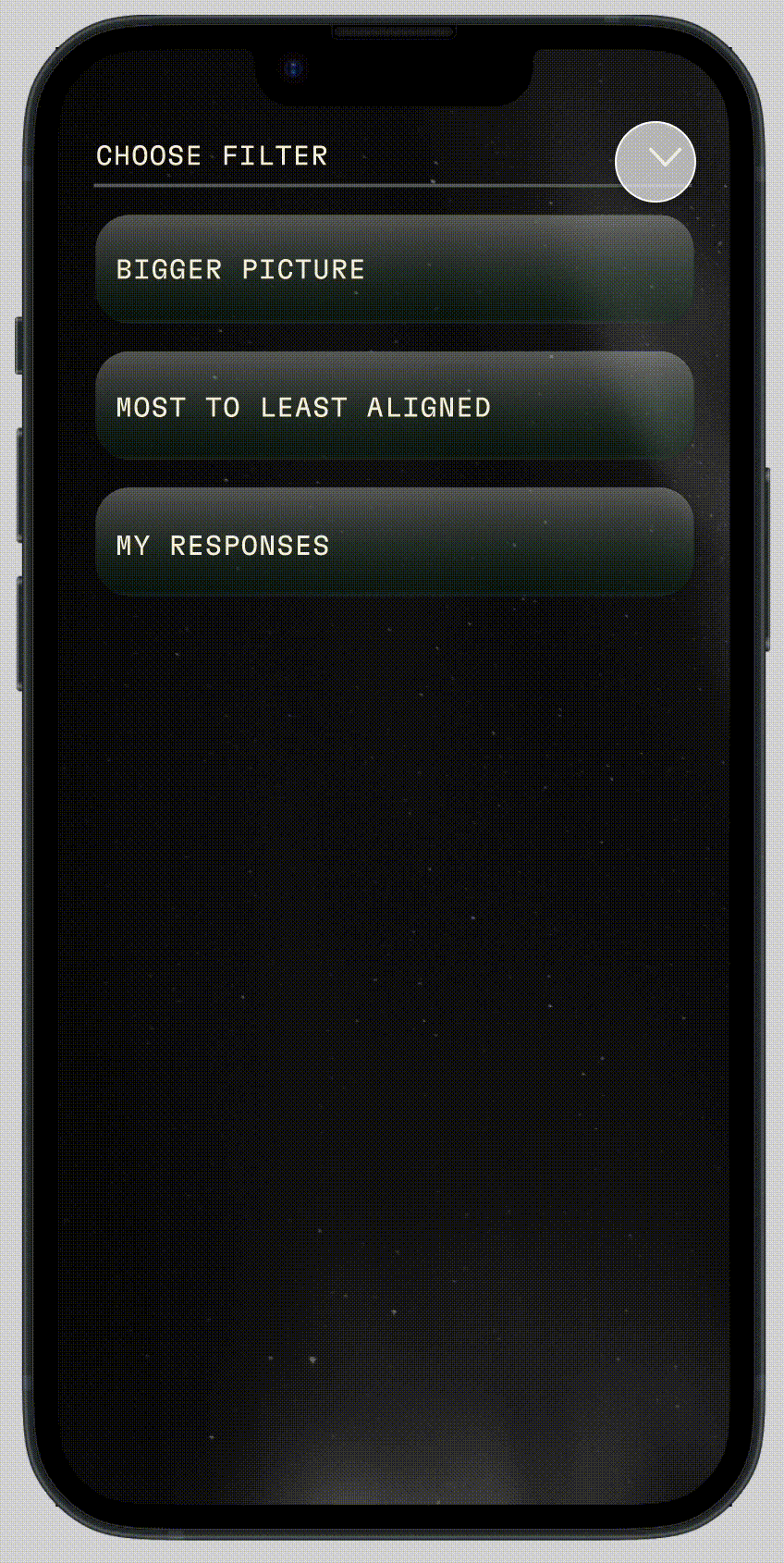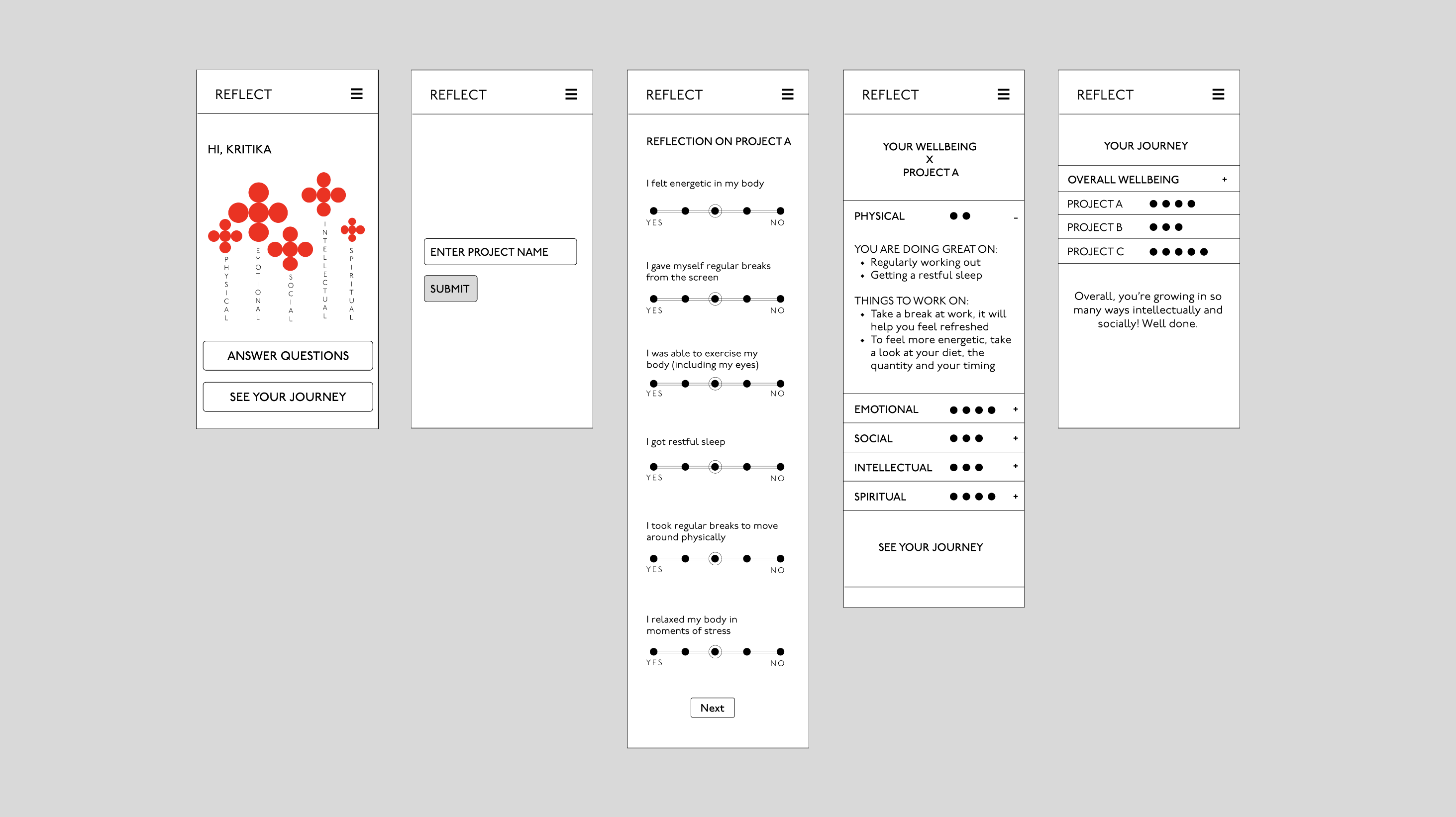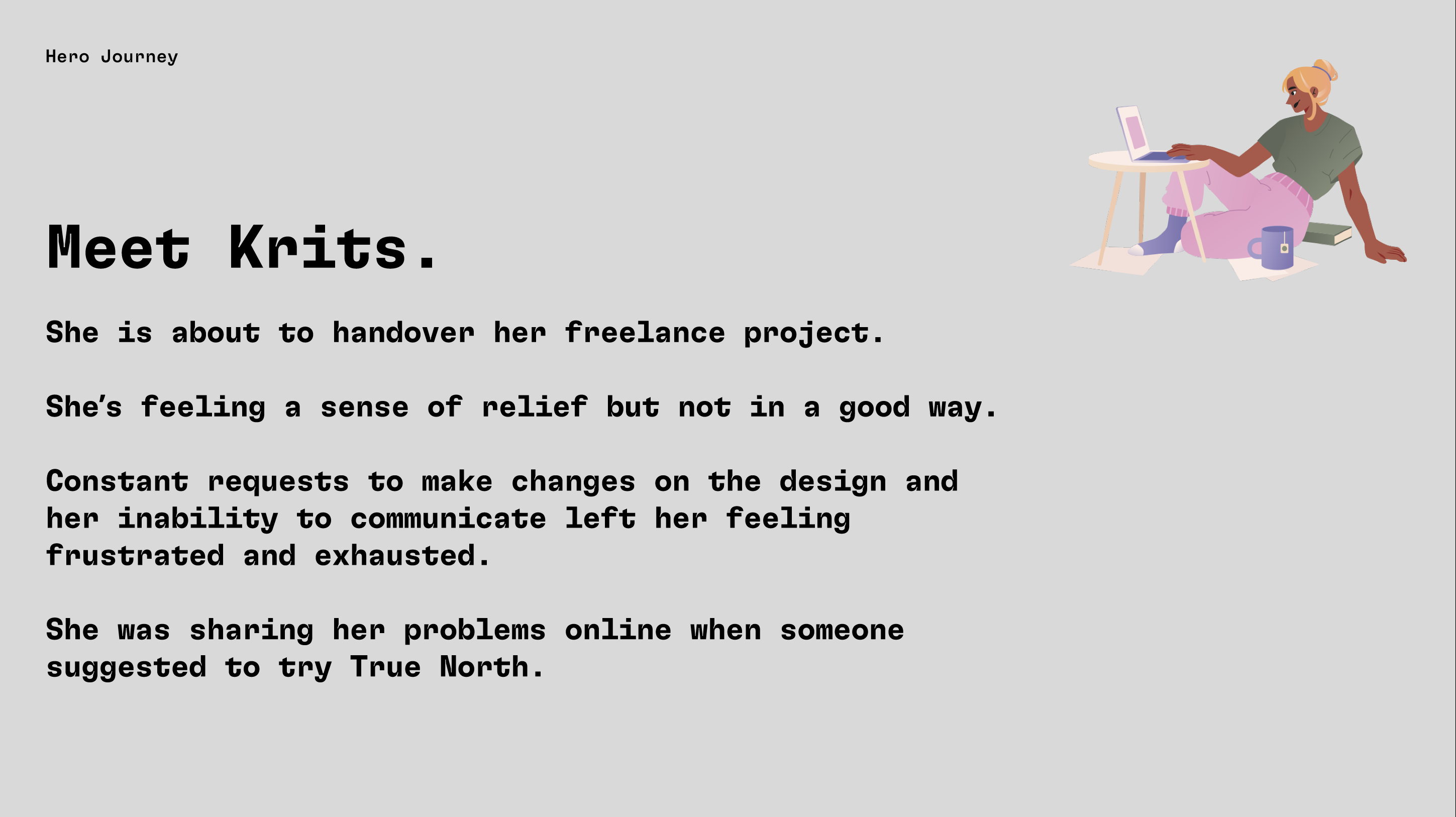
True North / App Design / Interaction Design
A creative wellbeing app for creatives
Problem
How might we help design professionals recognise as well as practice alignment with their professional goals?
How might we help design professionals recognise as well as practice alignment with their professional goals?
Outcome
I developed a unique mobile application for designers to document their careers through taking quick quizzes and evaluating their standing by analyzing their entire journey.
I developed a unique mobile application for designers to document their careers through taking quick quizzes and evaluating their standing by analyzing their entire journey.
Role
Product designer
Product designer
Team
Solo Project
Solo Project
Timeline
3.4 Months
3.4 Months
Software
Figma
Figma

Context
Solo professionals can struggle with their mental as they navigate their careers. Thus, True North is a wellbeing app to record and track their work experiences.
They can track how they felt physically, emotionally, intellectually, socially and spiritually during a project. This gives them an overall understanding of what worked and what could be improved.
Solo professionals can struggle with their mental as they navigate their careers. Thus, True North is a wellbeing app to record and track their work experiences.
They can track how they felt physically, emotionally, intellectually, socially and spiritually during a project. This gives them an overall understanding of what worked and what could be improved.
Impact
*The True North App is more relevant than ever; especially as 75% of global creatives experience burnout—a percentage that has only doubled since 2021 (Stats as per We Work report).
*Designed an app from conception to launch in 16 weeks. Conducted 50+ interviews for research and testing; designed 50+ lo-fi prototype ideas; iterated several UI screen designs for brand visibility and created 7+ interactive animations.
*The True North App is more relevant than ever; especially as 75% of global creatives experience burnout—a percentage that has only doubled since 2021 (Stats as per We Work report).
*Designed an app from conception to launch in 16 weeks. Conducted 50+ interviews for research and testing; designed 50+ lo-fi prototype ideas; iterated several UI screen designs for brand visibility and created 7+ interactive animations.
The App 1.0
STEP 01
![]()
- Evaluate a project holistically by taking a quiz

STEP 02
![]()
- Keep adding project evaluations

STEP 03
![]()
- Compare and analyse your evaluations

PROCESS
01
Research & Discovery
Desk Research
I. Write Annie Dillard famously quoted, “How we spend our days is how we spend our lives.” On an average we spend about a third of our lives working. Thus, it is safe to say that our work plays a crucial role in our lives.
Research & Discovery
Desk Research
I. Write Annie Dillard famously quoted, “How we spend our days is how we spend our lives.” On an average we spend about a third of our lives working. Thus, it is safe to say that our work plays a crucial role in our lives.
II. After Covid-19, there has been a surge in mental health app downloads. The design community has been proactively talking about prioritising mental health and supporting each other through online platforms such as Quora, Medium, Linkedin etc.
III. A research paper by Figma in 2022 talked about having honest conversations about our creative jobs and surveyed many designers by asking about what made them happy. Most designers valued practising their values more than their paycheck in the long run.






02
This research consisted of understanding factors that cause wellbeing and their relationship with apps designers use.
A research paper published in Berkeley stated that there are five main parameters that cause wellbeing, namely, physical, emotional, social, intellectual and spiritual. Tending to any of these adds to wellbeing in an indivdual’s life.
In the diagram, the apps on the right (without circles) are popularly classified ashealth and wellbeing apps. However, in this research I realised that when analysed through the 5 wellbeing parameters all apps cause some sort of wellbeing. It is the core essence of all our work. For instance, Skillshare, the app for learning skills not only causes intellectual wellbeing but also social and spiritual wellbeing.
Competitive & Analogous Research
This research consisted of understanding factors that cause wellbeing and their relationship with apps designers use.
A research paper published in Berkeley stated that there are five main parameters that cause wellbeing, namely, physical, emotional, social, intellectual and spiritual. Tending to any of these adds to wellbeing in an indivdual’s life.
In the diagram, the apps on the right (without circles) are popularly classified ashealth and wellbeing apps. However, in this research I realised that when analysed through the 5 wellbeing parameters all apps cause some sort of wellbeing. It is the core essence of all our work. For instance, Skillshare, the app for learning skills not only causes intellectual wellbeing but also social and spiritual wellbeing.

03
User Interviews
After an extensive understanding of the topic and the market, I set up qualitative research interviews with seven industry experts aka senior designers with 15+ years of experience. The choice to recruit these interviewees was to figure if there were any similar patterns to their approach to wellness, overcoming blocks along with what they did to sustain it.
I realised that while they had personal coping mechanisms, but “recognising ” the block was the first step for all and then “responding” rather than reacting to it came next. However, the main takeway was that WELLBEING IS SUBJECTIVE!
User Interviews
After an extensive understanding of the topic and the market, I set up qualitative research interviews with seven industry experts aka senior designers with 15+ years of experience. The choice to recruit these interviewees was to figure if there were any similar patterns to their approach to wellness, overcoming blocks along with what they did to sustain it.
I realised that while they had personal coping mechanisms, but “recognising ” the block was the first step for all and then “responding” rather than reacting to it came next. However, the main takeway was that WELLBEING IS SUBJECTIVE!

04
Synthesis & Key Insights
After synthesizing the qualitative and quantitve research, these were the 5 key insights.
While some of these deeply subjective and psychological, I realised making a digital product might not be the solution. However, I sketched out some How Might We’s and sketched some ideas to test.
Synthesis & Key Insights
After synthesizing the qualitative and quantitve research, these were the 5 key insights.
While some of these deeply subjective and psychological, I realised making a digital product might not be the solution. However, I sketched out some How Might We’s and sketched some ideas to test.

05
Lo-Fi Prototypes
Lo-Fi Prototypes
After gathering all my findings and synthesizing the research, I framed three how might we questions and sketched various concepts as my lo-fi prototypes. Then, tested these ideas via user inteviews.
#HMW 1
How might we support designers by creating actionable tools to help present themsleves/their studios with more and certainity?Solutions
Apps that help with
- pricing
- building a portfolio
- building all kinds of skills
- drafting a contract
- creating a project scope

User Testing Responses #1
Tested with3 x mid level freelancers
3 x recent graduate designers
4 x senior designers
My Insights
The starting out and mid level freelancers love functional tools to help since they are cluless how to price or draft a contract when starting out. Thus, they loved the app ideas with practical help.
However, the ones who were experienced didn’t find much value in the practical app because this problem wasnt for them so I took a step back and reconsidered the problem I was solving for.
The senior designer had a point that none of these were new. I wanted to solve a wellness issue and therefore I didn’t choose any of these prototypes.
#HMW 2
How might we help designers cultivate well balanced habits so that they recognise and advance their professional and personal needs?Solutions
Apps that help with:
- note taking (for work and emotional support)
- reframing (therapist and problem solving giude)
- mindful work
- alignment (aligning with work values)

User Testing Responses #2
Tested with
3 x mid level freelancers
3 x recent graduate designers
4 x senior designers
My Insights
None of the users seemed excited and had horrible reactions to these prototypes. It was a very clear indication of what wasn’t a viable product and thus, I chose to scrap these.

#HMW 3
How might we help designers recognise as well as practice alignment with their professional goals?Solution
App that asks questions for users to re-evaluate their work decisions

User Testing Responses #3
Tested with
2 x mid level freelancers
2 x recent graduate designers
2 x senior designers
My Insights
Asking questions and providing a visual aid to map the answers resonated with all creatives I tested with. I realised that even though this an elevated form of traditional questionnaires, by changing the kind fo questions and providing interesting visual cues I could create a really exciting product for all users and even scale to teams as well as beyond creatives.

06
Analysis
On reflection, I also realised how each of the apps catered to different well-being parameters. But I had a full circle moment when I realised that the chosen idea, aka the “Questions App” potentially checked all wellbeing buckets. Thus, I moved this design to mid-fi prototype.
Analysis
On reflection, I also realised how each of the apps catered to different well-being parameters. But I had a full circle moment when I realised that the chosen idea, aka the “Questions App” potentially checked all wellbeing buckets. Thus, I moved this design to mid-fi prototype.
07
of the Questions App
This mid-fi prototype was more text based version of my lo-fi idea.
Mid-Fi Prototype
of the Questions App
This mid-fi prototype was more text based version of my lo-fi idea. 

User Testing Responses #1
Tested with
2 x mid level freelancers
2 x recent graduate designers
2 x senior designers
My Insights
On synthesising user responses, it was clear that designers were leaning towards visuals rather than a text based app and thus I explored questions and data visualised the asnwers.

08
System Map
Next, I also drew a system map. The True North 1.0 app consists of the minimal viable product (MVP) i.e. the quiz and results.
Alongside this, onboarding was extremely important for users to understand how to use the app.
System Map
Next, I also drew a system map. The True North 1.0 app consists of the minimal viable product (MVP) i.e. the quiz and results.
Alongside this, onboarding was extremely important for users to understand how to use the app.

09
Introducing the mobile app, True North with a mission to help professionals evolve with intention.
Naming & Branding
Introducing the mobile app, True North with a mission to help professionals evolve with intention.


10
Hero Journey
Meet Krits, our hero and here is a walk-through of her True North App journey.
App Details
- On Opening the App, the user is greeted with an animation with the True North Arrow.
- Get started with entering project details accompanied by a button to start reflecting on a project
- The user needs to answer 6 questions. Each of these address a specific need, from physical, social, mental, emotional, spiritual and financial.
- Once the answers have been chosen, the next screen is an animation to showcase the answers using a True North arrow.
- The user then has a choice to enter any thoughts or takeways they’d like to remember from the project.
- The next screen is a results screen where the user can look at the results at a project level and also their whole journey of all the projects they have reflected on.
This helps them compare the results and understand when something felt great and when something did not very quickly and effectively just by looking at the shape of their arrow.
The goal is to create an arrow that is completely straight - this is aspirational and by reflecting over and over, users can work out strategies to work towards create a higher feeling of professional wellbeing.
Hero Journey
Meet Krits, our hero and here is a walk-through of her True North App journey.App Details
- On Opening the App, the user is greeted with an animation with the True North Arrow.
- Get started with entering project details accompanied by a button to start reflecting on a project
- The user needs to answer 6 questions. Each of these address a specific need, from physical, social, mental, emotional, spiritual and financial.
- Once the answers have been chosen, the next screen is an animation to showcase the answers using a True North arrow.
- The user then has a choice to enter any thoughts or takeways they’d like to remember from the project.
- The next screen is a results screen where the user can look at the results at a project level and also their whole journey of all the projects they have reflected on.
This helps them compare the results and understand when something felt great and when something did not very quickly and effectively just by looking at the shape of their arrow.
The goal is to create an arrow that is completely straight - this is aspirational and by reflecting over and over, users can work out strategies to work towards create a higher feeling of professional wellbeing.

11
Reflections
Mental Models: This project was challenging in terms of understanding mental models. Making people reflect on their life without it feeling like a chore and with a sense of excitement was tricky. But this is what made the project interesting to solve for as well.
Visuals: It was exciting to develop the visual concept for the app. The arrows felt like a fresh take on a wellness app.
Lingo: In terms of content accessibility, instead of using words like “lets go” it could be more clear if it said “Evalution a Project”. Even thought I have tested the questions but I’d like to test it even more to make sure these are super refined. I’d like to do this because I think these questions are the hro content that make this project truly helpful.
Onboarding: The project needs a few onboarding screens to explain the concept of the arrow and the aim with relfecting on these projects.
Additions: While there are so many ways to grow this project, some of those I thought would make it scalable are: adding more tracking parameters, adding options to reflect as a team and then individually, adding more in-depth questions if there is one specific problem area and sharing these in one’s community or social media.
Overall: I think True North did a great job at solving the problem of self evaluating growth and could provide true value to its users while being fun and visually compelling. I was very happy with the end product.
Reflections
Mental Models: This project was challenging in terms of understanding mental models. Making people reflect on their life without it feeling like a chore and with a sense of excitement was tricky. But this is what made the project interesting to solve for as well.
Visuals: It was exciting to develop the visual concept for the app. The arrows felt like a fresh take on a wellness app.
Lingo: In terms of content accessibility, instead of using words like “lets go” it could be more clear if it said “Evalution a Project”. Even thought I have tested the questions but I’d like to test it even more to make sure these are super refined. I’d like to do this because I think these questions are the hro content that make this project truly helpful.
Onboarding: The project needs a few onboarding screens to explain the concept of the arrow and the aim with relfecting on these projects.
Additions: While there are so many ways to grow this project, some of those I thought would make it scalable are: adding more tracking parameters, adding options to reflect as a team and then individually, adding more in-depth questions if there is one specific problem area and sharing these in one’s community or social media.
Overall: I think True North did a great job at solving the problem of self evaluating growth and could provide true value to its users while being fun and visually compelling. I was very happy with the end product.




